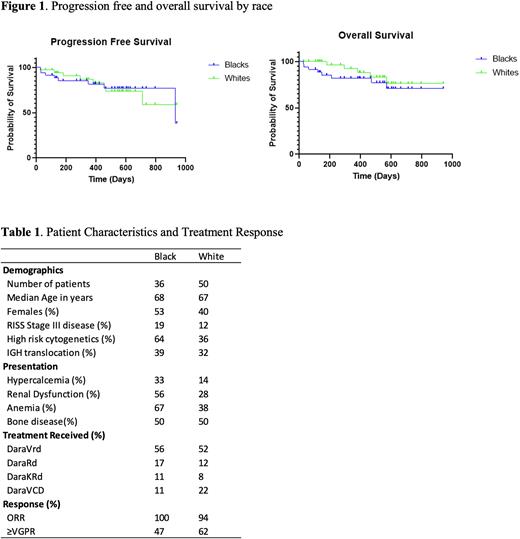Abstract
Background:
Black patients (pts) with dysproteinemia are underrepresented in clinical trials included in new drug applications and biological license application submissions. Even after approval, access to novel therapies remains a challenge. Daratumumab (dara) is an anti-CD38 monoclonal antibody, which has revolutionized the care of patients with both multiple myeloma (MM) and light chain (AL) amyloidosis. The underrepresentation of black pts in clinical trials of dara in newly diagnosed patients with dysproteinemia raises concerns regarding the safety, tolerability and efficacy of dara in this population. We report the results from a cohort of pts treated with dara in the management of newly diagnosed MM (NDMM) and AL amyloidosis.
Methods:
The Cancer and Aging Resilience Evaluation in Hematologic Malignancies (CARE-Heme) registry is an ongoing prospective registry enrolling pts ≥50 years of age with a diagnosis of hematologic malignancy undergoing treatment at a single institution. For this analysis, we included pts with NDMM and AL amyloidosis treated with dara-based combination therapy between January 2020 and January 2022. We obtained baseline disease- and patient-related characteristics. Toxicity was evaluated by chart review up to the first 6 cycles and adverse events (AEs) were graded using Common Terminology Criteria for Adverse Events (CTCAE v5.0). For patients receiving >1 cycle, response assessment was ascertained using International Myeloma Working Group (IMWG) uniform response criteria. All patients were followed until progression, death or last follow up and progression-free survival (PFS) and overall survival (OS) were measured using Kaplan Meier methods. Health-related quality of life (HRQoL) was measured using Patient-Reported Outcomes Measurement Information System (PROMIS) global 10 and quantified using physical health (PH) and mental health (MH) t-scores at baseline and 3 month follow up. Variables were compared in each race by using independent and paired sample t-tests as appropriate.
Results:
Over the study period, 36 black pts (NDMM=32; AL=4) and 50 white pts (NDMM=44; AL=6) received upfront dara-based combination therapy. There were no differences in age or sex, IGH translocations, but there was a higher incidence of cytogenetic high-risk disease among the black pts in our cohort (p=0.02). Black pts presented with more advanced disease at the time of presentation - hypercalcemia 33% vs. 14%, p=0.04; renal dysfunction 56% vs. 28%, p=0.01; anemia 67% vs. 38%, p=0.01). Incidence of bone disease was similar between the groups (p=0.69) (Table 1)
Among blacks, the most utilized regimen was DaraVRd (56%), DaraRd (17%), DaraKRd (11%) and DaraVCd (11%). While for the white pts, it was DaraVRd (52%), DaraRd (12%), DaraKRd (8%) and DaraVCd (22%).
Blacks had a similar incidence of ≥grade 3 non-hematologic AEs (p=0.21), with fatigue, diarrhea and leg edema being the most common. There is a trend towards higher ≥grade 3 hematologic AEs which did not reach statistical significance (p=0.05).
After 6 cycles of therapy, overall response rate was comparable (100% vs. 94%, p=0.81) among the two groups (≥VGPR 47% vs. 62%, p=0.36). With 18 month median follow up, there was no difference in median PFS and OS, both not reached (Figure 1).
Complete quality of life (QoL) t-scores were available at baseline for 55 pts (20 blacks and 35 whites). The baseline PH and MH related QoL scores were comparable between whites and blacks (p= 0.51; p=0.58, respectively). From baseline to 3 months follow up, PH t-scores improved in both whites as well as blacks although the difference was not statistically significant. Meanwhile, MH t-scores remained largely unchanged from baseline to follow up in both groups.
Conclusions:
We report the largest cohort to date of black pts with dysproteinemia systematically treated with frontline dara. Our data shows the feasibility of this strategy in a single institution setting with comparable safety, efficacy and HRQoL with the use of upfront dara-based combinations in black and white pts. Our data supports comparable clinical outcomes among black pts when treated with novel therapeutic combinations despite a higher proportion of high risk cytogenetic abnormalities in our cohort without an increase in AEs. Minority representation in cancer clinical trials as well as access to approved novel therapies can significantly help mitigate disparities in outcomes.
Disclosures
Giri:Pack Health: Research Funding; OncLive: Honoraria; CareVive: Honoraria, Research Funding. Costa:Sanofi: Consultancy, Honoraria; Bristol Myers Squibb: Consultancy, Honoraria, Research Funding; Adaptive Biotechnologies: Consultancy, Honoraria; AbbVie: Research Funding; Genentech: Research Funding; Amgen: Consultancy, Honoraria, Research Funding; Janssen: Consultancy, Honoraria, Research Funding. Bal:Adaptive Biotechnologies: Consultancy.
Author notes
Asterisk with author names denotes non-ASH members.


This feature is available to Subscribers Only
Sign In or Create an Account Close Modal